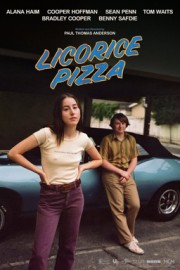Licorice Pizza
The Paul Thomas Anderson films that have connected with me the strongest are when he focuses himself on 1-2 characters, regardless of what the scope of the story is. His more expansive ensembles aren’t as successful for me because they don’t really afford him the chance to get intimate with his characters, find out what makes them tick beyond their place in the larger story. “Licorice Pizza” is very much my shit when it comes to PTA, even if it feels a bit too long, and meanders narratively. By the end, though, I’m all-in on his main characters and their journey. It’s thrilling to see them grow over this 133 minutes.
Phillip Seymour Hoffman was one of the best things of every movie he was in, but for PT Anderson, his characters had something even more electric to them that just left you watching their every move, whether it was a sympathetic nurse in “Magnolia,” a sex phone line owner in “Punch-Drunk Love” or a cult leader in “The Master,” he and Anderson had an alchemy together that just worked. When Anderson announced that Hoffman’s son, Cooper, was going to be one of the leads of “Licorice Pizza,” one could just write it off as a tribute to a friend or stunt casting if you wanted, but if you paid attention to how Seymour Hoffman was written by Anderson, you knew something special was in order. What becomes clear from the very first scene between Gary Valentine and Alana Kane (Alana Haim) is that the younger Hoffman is every bit as riveting as his father was on camera. It’s a star-making performance, and I wouldn’t be surprised if more Hollywood greats don’t line up to work with him.
Gary Valentine is a 15-year-old actor waiting in line for school pictures when he meets Alana, a 25-year-old who works for the photography studio; she is going up and down the line with a mirror. When Gary gets her to stop for him, he’s both checking his hair and chatting her up. He wants to have dinner with her. She says no; the age difference is just part of the reasoning. After that meeting, they do, in fact, get together, starting a connection that will sustain through highs and lows, and them figuring out what matters to them in life.
There are a lot of times when “Licorice Pizza” feels like Cameron Crowe’s “Almost Famous.” It’s not remotely set in the same universe (even though it is the same time period, roughly), but the dynamic between a younger guy feeling his way through an unorthodox adolescence and an adult woman who knows the life she wants to have is akin to that of William Miller and Penny Lane. At every moment, we almost expect Gary and Alana to succumb to the obvious connection they have, but Alana never lets him get too close. There are times when both characters display remarkable immaturity, and others when they seem older than their age. Hoffman and Haim are so wonderful and smart and engaging together- this feels like Jesse and Celine in the “Before” trilogy; I wonder if these are characters Anderson might return to over the years.
Sometimes, a movie has a sequence that is just so wonderfully, and comedically, structured and executed it makes some of the negative feelings you might for a movie just vanish. “Licorice Pizza” has such a sequence involving Gary, Alana, a moving truck with some of Gary’s friends in the back, and Bradley Cooper as mega-producer Jon Peters that is one of those moments. I couldn’t help but think of the Quaalude sequence in “The Wolf of Wall Street” when I saw it, not because it’s a similar moment, but because it’s an example of a great filmmaker just coming up with an idea, telling his actors what their assignments are, and figuring out how to execute it in a way that is nothing short of a tour de force. There’s an earlier moment that rivals this one in a restaurant involving Sean Penn and Tom Waits with probably the most satisfying conclusion of a scene in the movie.
This movie is as personal for Paul Thomas Anderson as any he’s ever made. The film doesn’t traffic in 1970s nostalgia, but it’s essential that it’s set at that time, because there are events and styles that add to the texture of the story, and give us a great sense of time and place. His use of music, whether it’s existing songs or Jonny Greenwood’s score, remains on-point, and the film- shot by he and Michael Bauman- is simply gorgeous to look at. “Licorice Pizza” doesn’t quite reach the top of my Paul Thomas Anderson ranking, but I can see myself returning to it over the years more than just about any other film he’s ever made.










